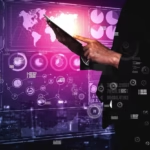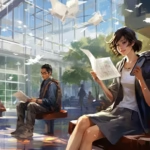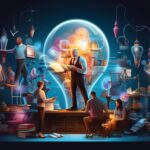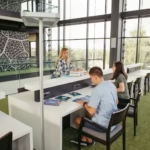Clare and Marcela met at her opening this spring and got to talking about Marcela’s work. Marcela graduated from SFAI with her MFA. She originates from Colombia and her work utilizes photography, color, and objects to create staged photos that question our paranoia and ideas surrounding race and gender.
For me, the idea of Paranoia is very closely related to home in Colombia, and is also just as present in life in the United States. Everything we do / consume / enjoy is framed as a potential danger. Paranoia is very closely related to control and power and is often is based in assumptions or ideas that have been ingrained in us. There is paranoia and fear towards each other, very often towards those that are disadvantaged, underprivileged, or even disabled. We rarely fear those who are in power, who delineate our discourse, who control the supply of our basic needs, etc.For me, it has been empowering to become aware of the sources of fear in my life, to confront and question them.Although your work deals with issues of race and gender which can often be seen as heavy topics, there is a sense of playfulness, humor and ambiguity in your photographs. What are your intentions when using humor or playful juxtapositions? What responses in the viewer are you hoping to illicit?I think the use of ambiguity allows for multiples readings of my photos, which is ideal. I’m not interested in describing a conclusion or a fixed message.
The best part of an artistic practice is that the way in which topics are addressed is methodless. The art platform is so bendable that it can be reinvented every time. I’m interested in luring the audience into my piece with formal elements to later discover complex and playful metaphors regarding ideas of difference. My way to address difficult conversations has been more effective, subversive and memorable when I allow myself to use humor. In a way, it gives me agency to be critical while also allowing for a later conversation.
Has living in two different countries and cultures (Colombia and the US) shaped the way you see issues of race and gender? Have you experienced a different cultural understandings of race and gender? Has this affected your work? If so, how?
When I moved to the US I became extremely aware of racial relationships. I mean at home there is racial inequality too, and those who are better off are also majority white – it’s some sort of pigmentocracy. But for me, the US racial inequality felt so undeniable, so shameless, so blatantly evident. Perhaps the contradiction lied in the fact that while the US claims to be so developed and equal, giving opportunities for all, once I lived here the whole discourse collapsed. Besides, what became more important for me was the obliviousness to this inequalities by those who are privileged.
What informs your decisions when selecting materials and building props for staging photographs?
The process varies for me. Sometimes I go to friends’ houses and I get obsessed with objects or spaces they inhabit. Once I come up with an idea, I borrow those objects or use those spaces. I also go to thrift stores and like the idea of letting objects ‘flirt’ with me. Once in the studio I enjoy changing the object a bit, either by color or function, or altering it in some other way. I think I rarely photograph objects in the way they were made to be used.
I’ve noticed that in many of your photographs there is a subtle sense of breaking with the natural laws of gravity and space. Is there a deeper meaning in creating this sense of unexpected behavior in familiar objects?
There is something extremely attractive to me regarding photography in that sense. It is possible to make anything go in any direction of the frame, and for that reason, it’s often ‘easier’ working with object than subjects. There is also the possibility of creating an alternative universe in which things behave ‘erroneously’. In a way, the erroneous becomes idiosyncratic and celebrated, and normal becomes dull / uninteresting / boring.
I played a lot of music when I was growing up, I thought I was going to be a musician, until I started taking photos. For me, visual composition and musical composition are very closely related. It’s a balanced arrangement of elements, it’s not always pleasant, but it always has a purpose. Nevertheless, composition can be so boring when one follows the rules to the core, and on the extreme, cacophonies can also be repellent. In that way, I enjoy luring the audience through formal elements or recognizable visual language, while also incorporating unexpected elements and ideas into the pieces that make the piece for successful and unanticipated.
As an artist working in the genre of staged photography, are there any artists in this genre who have inspired you or influenced your work?There is a few I can think of. Duane Michals was the first artist I got exposed to that really resonated with me. Michals was so playful and sincere, and yet critical in a way. He was not into gay activism per se but his photo sequences, which included improbable narratives and text, were always so sharp, witty and queer. He celebrated the unexpected and the bizarre in a way that felt very refreshing to me. I also really admire the work of Barbara Kasten, Sandy Skoglund and Elmgreen & Dragset.
What opportunities did a graduate level art education offer you?
I started graduate school looking for an immersive environment. I work well with people, and I get really inspired by energy and new ideas around me. I think it is fundamental to create work while also learning about contemporary art. Looking back at the two years, I was able to create a community around me that was critical, honest and that had a great sense of humor. We are all still learning from each other, celebrating, questioning and growing. I really enjoy working that way.
How important do you think art education is for establishing an art practice?
Well, I think it really depends. I think art education can allow you to enter an art community in a city, to make connections with people, and to meet mentors and companions that will become essential in your development as an artist. I guess for me what was so valuable was the level of intentionality of the conversations, to see people deep in their research and learn about what they are passionate about on a really deep level. We all become obsessed with things we are learning about and we share it with each other. It’s very special in that way.
What directions is your work currently taking you in?
I think I have multiple takes on my work lately. One side, which seems to be more relevant to me as an artist in this moment in time, is the re- understanding of the art history I’ve learned and the way it has been taught to me: meaning, too masculinized and over-simplified. I’m in the process of finding out about all those artists that were never shown to me that are so fundamental to where I am now – lots of women, queer artists, and artists of color that have been pushed outside of the narrative we learn. So I’m looking to question some old fashioned ideas about photography and its presentation, but that also involves questioning my own preconceptions around the medium.
You have an upcoming exhibition at Bass & Reiner Gallery in San Francisco. Can you tell us more about what you are working on for that show?
Currently I’ve been diving into The Queer Art of Failure by Judith Halberstam which explains and asks for failure to be considered differently. We’ve always thought about perfection, success and productivity in such a rigid way, we have yet to reconsider failure and different ways of being as a positive/beautiful alternative.
I’ve also been having a lot of conversations with myself about the idea of presentation and artwork presentation more specifically. So I’m working on a series that deconstruct the idea of the matte board as a tool for presentation and I’m trying to transform it into subject matter. I’m thinking is time to let the matboard show its true potential. In Colombia we called matboard Paspartú and in Mexico they call it Marialuisa, as if they were their own characters. I guess I’m interested in anthropomorphizing this seemingly dull and square object. Let’s see what happens.









